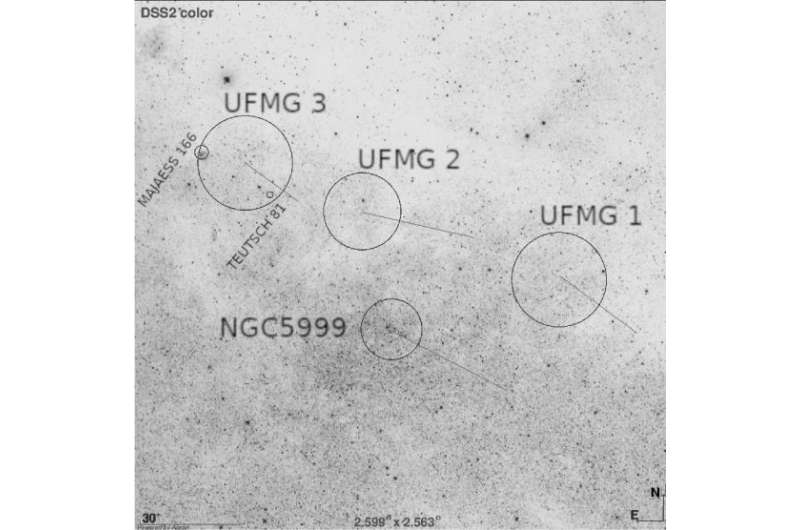January 7, 2019 report
Three new open clusters discovered in the Milky Way

Using data from ESA's Gaia satellite, Brazilian astronomers have detected three new open clusters in the Milky Way. The clusters, designated UFMG 1, UFMG 2 and UFMG 3, were found in the Sagittarius arm of the galaxy. The discovery is reported in a paper published December 27 on the arXiv.org pre-print server.
Open clusters, formed from the same giant molecular cloud, are groups of stars loosely gravitationally bound to each other. So far, more than 1,000 of them have been discovered in the Milky Way, and scientists are still looking for more, hoping to find a variety of these stellar groupings. Expanding the list of known galactic open clusters could be crucial for improving our understanding of the formation and evolution of our galaxy.
Now, a group of astronomers led by Filipe A. Ferreira of Federal University of Minas Gerais in Belo Horizonte, Brazil, reports the identification of a trio of new open clusters in the Sagittarius arm, in the field of the intermediate-age cluster NGC 5999. By analyzing the data from the Gaia Data Release 2 (DR2) regarding the region adjacent to NGC 5999, they noticed the existence of other clusters not yet reported by previous studies.
"We report the serendipitous discovery of three new open clusters, named UFMG 1, UFMG 2 and UFMG 3 in the field of the intermediate-age cluster NGC 5999, by using Gaia DR2 data," the paper reads.
The newly identified clusters are located some 4,900 light years away from the Earth and contain at least a few hundred stars of nearly solar metallicity. The researchers estimate that the clusters have ages between 0.1 and 1.4 billion years.
According to the paper, UFMG 1, UFMG 2 and UFMG 3 have limiting radii (the radius where the stellar density reaches the sky level) of 20.5, 15.6 and 19.5 light years respectively. For comparison, NGC 5999 has a limiting radius of about 15 light years. UFMG 1 and UFMG 2 have a more dense core when compared to UFMG 3, which exhibits a sparser central structure.
Furthermore, the astronomers noted that UFMG 3 is located in the sky near two other known clusters: Majaess 166 and Teutsch 81. They added that the two objects are probably distant clusters projected in the direction of UFMG 3.
Gerais' team also note that all the newly identified open clusters have well-defined main sequences and contain at least two giants, facilitating the isochrone fitting procedure. However, UFMG 2 has a developed red giant clump and presents a broader main sequence. This, according to the researchers, possibly indicates differential reddening and/or stellar populations with slow rotators (bluer stars) and fast rotators (redder stars), as is in the case of the open cluster known as "Wild Duck Cluster" (other designation Messier 11, or M 11 for short).
More information: Filipe A. Ferreira. Three new Galactic star clusters discovered in the field of the open cluster NGC 5999 with Gaia DR2. arXiv:1812.10795 [astro-ph.GA]. arxiv.org/abs/1812.10795
© 2019 Science X Network


















